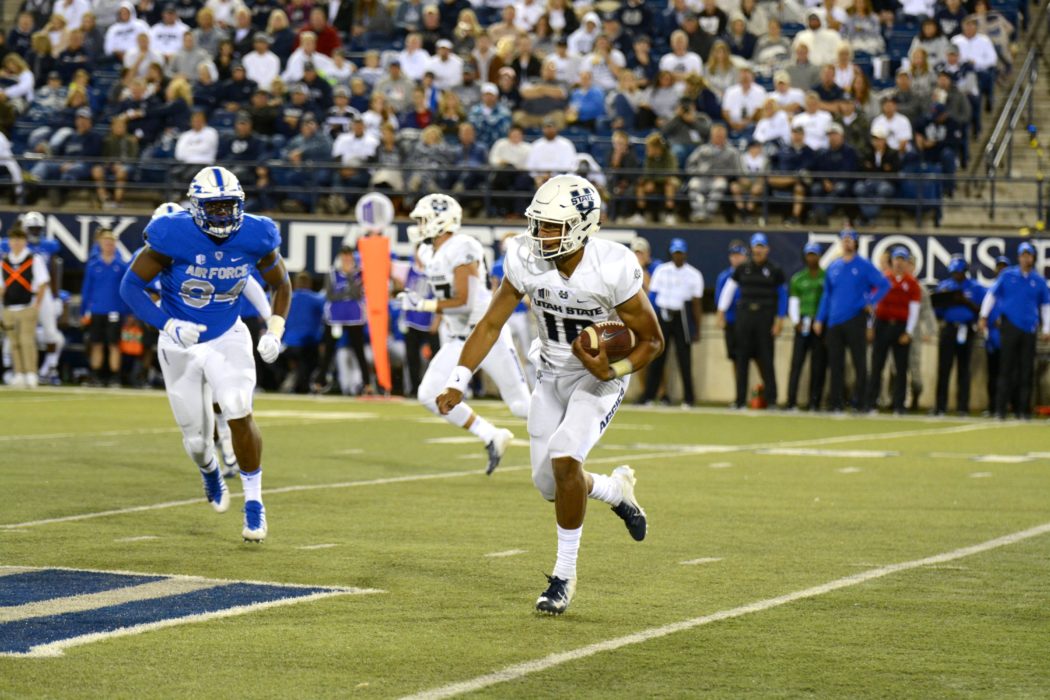By the Numbers: USU vs. Air Force
5 – Aggie drives that lasted for more than one minute
I think we all know this is a fast-paced Utah State offense which can make things happen in a hurry, but this is getting ridiculous. The Aggies only possessed the ball for 16:20, which is insane, but it’s even more insane when you realize they had 16 possessions and scored 42 points. It’s truly become a thing of beauty to watch how efficient this offense is at times. The average drive for USU lasted just 1:05. While Utah State ranks 126th in the nation in time of possession this season, that’s really not a good thing nor a bad thing. Looking at the teams which are similar in time of possession, the Aggies are surrounded by some elite-level teams such as Clemson, Oklahoma and UCF, while there are also some dumpster fires like SMU and New Mexico State with similar numbers. It’s not about the speed of the offense, it’s about its effectiveness, and props go out to Coach Yost and the Aggies for putting together an offense that can make it work.
4.3 – Average yards per play allowed by the USU defense
As maddening as it is to watch a triple-option team possess the ball for 43:40 and run 108 plays in a game, I thought the Aggie defense was spectacular. Air Force is a team which will pick a defense apart with methodical, disciplined running, then capitalize when a defender tries to do too much. The Utah State defense stayed disciplined and really didn’t allow that to happen very much in this game. Last season, the Falcons were held to 4.3 yards per play or less just three times, and all three resulted in losses. If a team were to be averaging 4.3 yards per play on the season right now, they would rank seventh to last in the nation. I was just very impressed with the discipline of this Aggie defense to never really let up on a team that, quite frankly, sucks to defend.
8.8 – USU’s average gain on first down
One of the biggest benefits to the hurry-up offense that Utah State runs (if done effectively) is the ability to catch the defense sleeping after moving the chains and breaking out a big play. They were able to do just that on Saturday night. The Aggies ran 33 first down plays, of which, nine went for 10+ yards, 10 went for between 4-9 yards, and 14 went for less than three yards. That’s not bad. The flip-side of that is the fact that Utah State also averaged 8.2 yards-to-go when they got into third down situations, which happened nine times, and they were only able to convert on three of them. Five of USU’s six failed third-down conversions attempts came on drives which started with either an incomplete pass or a run of two yards or less.
4 – Three-and-outs by the Aggie offense
As many good things as we saw from Utah State on both sides of the ball, there were a few not-so-good things. The turnovers and dropped catches were the obvious ones, but for an offense which plays the way USU’s offense does, three-and-outs can be disastrous. Here’s how much time each three-and-out drive took off the clock for the Aggies: :19, :30, :45, 1:20. So that’s an average of just 43.5 seconds of game time that the defense was on the bench before heading back onto the field. Utah State has proven to have a pretty deep defense which can rotate in and out, helping with fatigue, but there were several defensive players who took 100-plus snaps against Air Force. Moving forward, it will become more and more important for the USU offense to figure out how to extend drives and avoid three-and-outs.

